Ursicinus of Cahors or Urcis or Saint Urcsicinus was a bishop of Cahors from the early 580s until his death in around 595. His feast day is on December 13. [1] Ursicinus was the chancellor of queen Ultragotha, wife of Childebert I, king of Paris. He was chosen by Maurilio, then-bishop of Cahors, to be his successor.
In 585, the Second Synod of Mâcon, assembled at the request of king Guntram of Orléans, began to conduct trials of those who had declared themselves in favor of the rebel Gundowald, who claimed to be the son of Clothar I. Ursicinus publicly confessed to having received Gundowald and having declared himself in his favor. The synod sentenced him to three years' penance. During this penance he had to let his beard and hair grow (priests of the time wore tonsure and no beard), not to consume meat and wine, not to celebrate mass, not to ordain priests, nor to consecrate churches or bless bread. [2] During this penance, St. Gregory of Tours recounts an event as one indicative of the greed of bishops of the era. [3] Innocent, count of Gévaudan and elected bishop of Rodez under pressure from Brunhilda of Austrasia, attempting to claim more land, accused Ursicinus of unjustly holding parishes that should be under the bishopric of Rodez. To judge this dispute, Sulpitius, the archbishop of Bourges, convened a council in Clermont in 587. It was decided there that the bishop of Cahors would keep the parishes for which the bishop of Rodez could not prove that a bishop of Rodez had exercised his authority there. [4]

The Archdiocese of Bordeaux (–Bazas) is a Latin Church ecclesiastical territory or archdiocese of the Catholic Church in France. The episcopal see is Bordeaux, Aquitaine. It was established under the Concordat of 1802 by combining the ancient Diocese of Bordeaux with the greater part of the suppressed Diocese of Bazas. The Archdiocese of Bordeaux is a metropolitan see, with four suffragan dioceses in its ecclesiastical province: Dioceses of Agen, Aire and Dax, Bayonne, and Périgueux.
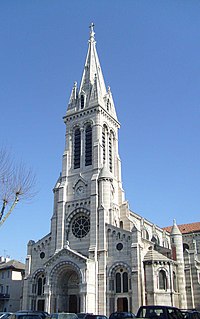
The Diocese of Gap and Embrun is a Latin Church ecclesiastical territory or diocese of the Catholic Church in Provence-Alpes-Côte d'Azur region of Southern France.

The Roman Catholic Diocese of Tulle is a Roman Catholic diocese in Tulle, France. The diocese of Tulle comprises the whole département of Corrèze.
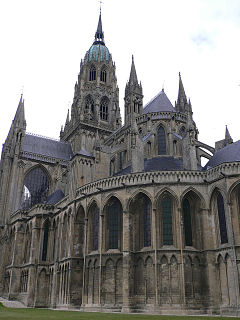
The Roman Catholic Diocese of Bayeux and Lisieux is a diocese of the Roman Catholic Church in France. The diocese is coextensive with the Department of Calvados and is a suffragan to the Archdiocese of Rouen, which is also in Normandy.
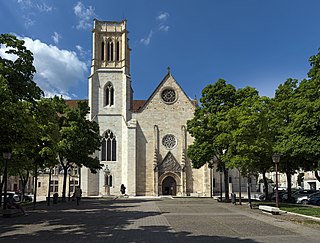
The Diocese of Agen is a Latin Church ecclesiastical territory or diocese of the Catholic Church in France.

The Roman Catholic Diocese of Saint-Flour is a diocese of the Latin Rite of the Roman Catholic Church in France. The diocese comprises the department of Cantal. Erected in 1317, the diocese was suffragan of the Archdiocese of Bourges until 2002. With the general reorganization of the structure of the French church by Pope John Paul II, Saint-Flour became the suffragan of the Archdiocese of Clermont. The seat of the bishop is located in Saint-Flour, Cantal.
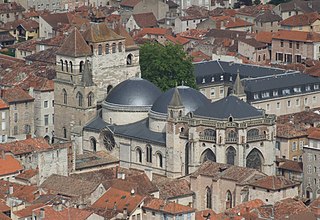
The Roman Catholic Diocese of Cahors is a diocese of the Latin Rite of the Roman Catholic Church in France. The diocese comprises the whole of the department of Lot.

The Diocese of Rodez (–Vabres) is a Latin Church ecclesiastical territory or diocese of the Catholic Church in France. The episcopal see is in Rodez. The diocese corresponds exactly to the Department of Aveyron.

Western Rite Orthodoxy, also called Western Orthodoxy or the Orthodox Western Rite, are congregations within the Eastern Orthodox tradition which perform their liturgy in Western forms.

The former French Catholic diocese of Saint-Pons-de-Thomières existed from 1317 until the French Revolution. Its see at Saint-Pons-de-Thomières in southern France is in the modern department of Hérault. There was the Abbey of St-Pons, founded in 936 by Raymond, Count of Toulouse, who brought there the monks of St-Géraud d'Aurillac.

The Roman Catholic Archdiocese of Albi (–Castres–Lavaur), usually referred to simply as the Archdiocese of Albi, is a non-metropolitan archdiocese of the Latin Rite of the Catholic Church in southern France. The archdiocese comprises the whole of the department of Tarn, and has itself been suffragan, since the 2002 provinces reform, to the Archdiocese of Toulouse, a metropolitan archdiocese.

The Diocese of Dax or Acqs was a Roman Catholic ecclesiastical territory in Gascony in south-west France. According to tradition it was established in the 5th century. It was suppressed after the French Revolution, by the Concordat of 1801 between First Consul Napoleon Bonaparte and Pope Pius VII. Its territory now belongs to the Diocese of Aire and Diocese of Bayonne.
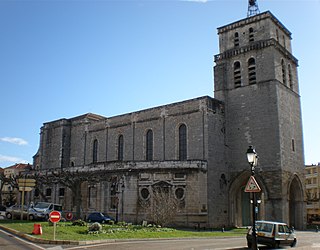
The former French Catholic diocese of Alais was created in 1694, out of territory previously part of the diocese of Nîmes. It was suppressed after the French Revolution, with its territory being divided between the diocese of Avignon and the diocese of Mende. Its seat was Alès Cathedral.

The Roman Catholic Archdiocese of Toulouse is a Latin Church ecclesiastical territory or archdiocese of the Catholic Church in France. The diocese comprises the Department of Haute-Garonne. Its see is Toulouse Cathedral, in the city of Toulouse, and the current archbishop is Robert Jean Louis Le Gall, appointed in 2006 and translated from the Diocese of Mende.

The Roman Catholic Archdiocese of Clermont is an archdiocese of the Latin Rite of the Roman Catholic Church in France. The diocese comprises the department of Puy-de-Dôme, in the Region of Auvergne. The Archbishop's seat is Clermont-Ferrand Cathedral. Throughout its history Clermont was the senior suffragan of the Archdiocese of Bourges. It became a metropolitan see itself, however, in 2002. The current archbishop is François Kalist.

The Roman Catholic Diocese of Montauban is a diocese of the Latin Rite of the Roman Catholic Church in France. The diocese is coextensive with Tarn-et-Garonne, and is currently a suffragan of the Archdiocese of Toulouse. The episcopal seat of the Diocese of Montauban is in Montauban Cathedral.

Pierre Desprès (1288–1361) was a French Cardinal during the period of the Avignon Papacy.

Sulpitius I was Bishop of Bourges. Often called Sulpitius Severus, the Severe, he is wrongly identified with Sulpicius Severus, the historian of Saint Martin of Tours.

Ultragotha, 510 - after 566/567, was a Frankish queen of the Merovingian dynasty via her marriage to Childebert I, reigning from c.541-558. They had two daughters, possibly named Chrodoberge and Chrodesinde.
This page is based on this
Wikipedia article Text is available under the
CC BY-SA 4.0 license; additional terms may apply.
Images, videos and audio are available under their respective licenses.


















